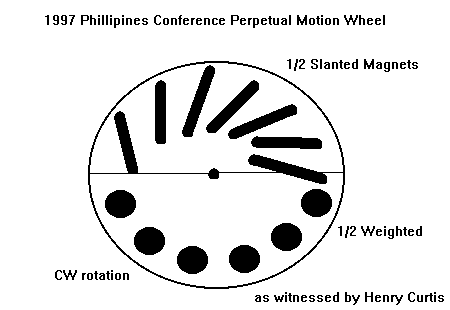Korean Magnetic Perpetual Motion Wheel - 11/18/97
I must apologize for not having all the details of this interesting device
but will update the file when I get more info from the source.
In email communications with John Schnurer, I happened to mention it and
he's been on me since then to send him a diagram, yet I felt like it would
simply be confusing because its operation is not clear or readily apparent from
the information I had.
The information that I have comes directly from long time friend Henry
Curtis of Colorado. We both attended the 1997 ISNE conference in Denver and
Henry was telling about this interesting machine he had seen while on a trip to
the Phillipines.
He said there was a free energy conference held there and he noticed a
spinning bicycle wheel that was attached to a stand that sat on a table.
The wheel was running when he first saw it, yet there did not appear to
be any driving force such as a motor, belts, gears, etc..
Henry said he watched it for quite awhile and it never stopped running.
On expressing curiosity about the wheel, he was invited to stop it and start it
up without any outside assistance.
Henry reports the wheel was brought to a complete stop, then he gave it a
spin with his hand and it began moving on its own.
I am uncertain if it followed the tendency of other such devices to
establish its own speed. Some devices like this can be spun up to high speed
from an outside source, then will slow to a speed which is determined by the
geometry and strength of the repelling or attracting forces that operate it.
Henry swears it was the neatest thing he'd ever seen and drew a crude
diagram of the arrangement on my notepad. Unfortunately, we were a bit rushed
and I did not achieve a complete understanding of how it operated. That is why I
did not want to blow smoke about it until more detail had been received, god
knows, we don't need any more of that.
However, perhaps someone can figure it out from the limited information I
do have. The following drawing shows the wheel arrangement, one half was
weighted, the other half had slanted magnets. I do not know whether they are all
repelling, attracting or a mix of these forces.
 As you can imagine, the weight of the magnets must equal the weight of
the other half of the wheel to balance out. Apparently the force of the magnetic
repulsion or attaction provides the actual imbalance.
Henry also said there was a patent on this device that is dated January
14, 1997. The inventor is a Japanese man named Minatu. The spelling of this name
is uncertain. I did a search on the IBM server but found nothing even remote.
Henry specifically said this was a United States patent.
So, here it is. Perhaps Henry can come up with some more detail which can
be used to update this file in future. Good luck....
As you can imagine, the weight of the magnets must equal the weight of
the other half of the wheel to balance out. Apparently the force of the magnetic
repulsion or attaction provides the actual imbalance.
Henry also said there was a patent on this device that is dated January
14, 1997. The inventor is a Japanese man named Minatu. The spelling of this name
is uncertain. I did a search on the IBM server but found nothing even remote.
Henry specifically said this was a United States patent.
So, here it is. Perhaps Henry can come up with some more detail which can
be used to update this file in future. Good luck....

